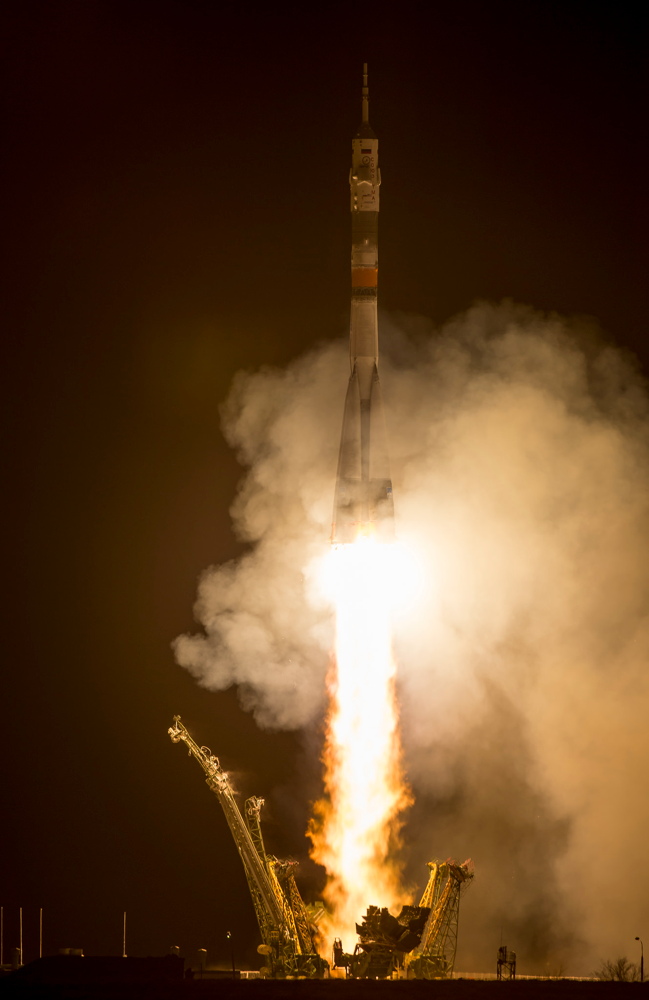
Two spaceflyers blasted off on the first-ever yearlong mission to the International Space Station, NASA announced its plan to haul a boulder from a near-Earth asteroid to lunar orbit and yet more ingredients for life were found on Mars. Here's a look at Space.com's top stories of the week.
1-year space station mission blasts off
A Russian Soyuz spacecraft launched the International Space Station’s first one-year crew on Friday (March 27), kicking off an epic voyage for NASA astronaut Scott Kelly and Russian cosmonaut Mikhail Kornienko. [Full Story: Liftoff! US, Russia Launch Historic One-Year Space Mission]
The science of the yearlong space station mission
Science experiments conducted on the International Space Station during the orbiting outpost's first yearlong mission could help open the door to deep space for NASA. [Full Story: A Year in Space: The Science Behind the Epic Space Station Voyage]
NASA opts to pluck a boulder, not grab a whole asteroid
NASA's bold asteroid-capture mission will pluck a boulder off a big space rock rather than grab an entire near-Earth object, agency officials announced Wednesday (March 25). [Full Story: For Asteroid-Capture Mission, NASA Picks 'Option B' for Boulder]
Get the Space.com Newsletter
Breaking space news, the latest updates on rocket launches, skywatching events and more!
'Fixed' nitrogen found on Mars
Nitrogen was available on ancient Mars in a form that microbes could have used to build key biomolecules, and atmospheric carbon monoxide has been a feasible energy source for life throughout the Red Planet's history, two new studies suggest. [Full Story: More Ingredients for Life Identified on Mars]
Opportunity rover completes its Mars marathon
NASA's Opportunity rover has completed the first-ever Mars marathon, clocking in with a winning time of 11 years and two months. [Full Story: NASA's Opportunity Rover Wins 1st Marathon on Mars]
Jupiter the wrecking ball
Jupiter may have acted like a giant wrecking ball in the newborn solar system, roaming in to destroy an early generation of inner planets before retreating to its current orbit, researchers say. [Full Story: Jupiter's 'Smashing' Migration May Explain Our Oddball Solar System]
Saturn's day length recalculated
Measurements taken by NASA's Cassini spacecraft have shown that Saturn might have a longer day than originally calculated from measurements taken by the Voyager 2 probe more than 20 years earlier. [Full Story: Length of Saturn's Day Measured Like Never Before]
Black hole winds can alter galaxy evolution
Giant winds from black holes can blast gas through galaxies at extraordinary speeds, pulling the plug on star formation, researchers say. The discovery reveals how black holes can direct the fates of entire galaxies. [Full Story: Black Hole Winds Quench Star Formation in Entire Galaxies]
New evidence in case of Milky Way's mystery object
New observations may finally reveal the identity of a mystery object circling around the monster black hole at the center of our Milky Way galaxy — or not. [Full Story: New Evidence May Identify Mystery Object at Milky Way Galaxy's Core]
Shedding light on dark matter
Dark matter may not be part of a "dark sector" of particles that mirrors regular matter, as some theories suggest, say scientists studying collisions of galaxy clusters. [Full Story: Dark Matter Probably Isn't a Mirror Universe, Colliding Galaxies Suggest]
European comet lander still silent
Europe's Philae spacecraft, which made the first successful soft landing on a comet last year before going silent, hasn't responded yet to hails from its orbiting Rosetta mothership. [Full Story: On Comet, Philae Lander Still Silent as Europe Keeps Listening]
Follow Mike Wall on Twitter @michaeldwall and Google+. Follow us @Spacedotcom, Facebook or Google+.
Join our Space Forums to keep talking space on the latest missions, night sky and more! And if you have a news tip, correction or comment, let us know at: community@space.com.

Michael Wall is a Senior Space Writer with Space.com and joined the team in 2010. He primarily covers exoplanets, spaceflight and military space, but has been known to dabble in the space art beat. His book about the search for alien life, "Out There," was published on Nov. 13, 2018. Before becoming a science writer, Michael worked as a herpetologist and wildlife biologist. He has a Ph.D. in evolutionary biology from the University of Sydney, Australia, a bachelor's degree from the University of Arizona, and a graduate certificate in science writing from the University of California, Santa Cruz. To find out what his latest project is, you can follow Michael on Twitter.










